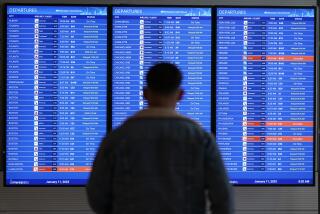Airlines report lofty profit margins
- Share via
The nation’s airlines continue to show signs of a strong recovery and healthy profits after one of the worst slumps since the terrorist attacks of 2001.
Bolstered by growing demand and new fees to check luggage and other charges, U.S. airlines posted the highest third-quarter profit margins in at least four years, according to a financial report released Monday by the U.S. Department of Transportation.
Industry analysts predict clear skies for the airlines into the near future.
“At least in 2011, it looks like the positive numbers are going to continue,” said Bob McAdoo, a senior airline analyst at Avondale Partners, a Nashville-based investment bank.
Large carriers, such as Delta Air Lines and American Airlines, reported a profit margin of 10.5% in the third quarter of 2010, the highest quarterly rate since the agency began keeping financial airline statistics in 2002. The country’s low-cost airlines, such as Southwest Airlines and JetBlue Airways, reported an 11% profit margin for the three-month period, the highest since the second quarter of 2006.
The report comes as the industry is in the midst of a busy holiday travel season with rising ticket prices. At Los Angeles International Airport, for example, airport officials predict holiday travel will increase by about 1.3%, to nearly 2.9 million passengers, compared with last year’s holiday season.
Meanwhile, domestic airfares have been on the rise since the summer of 2009. In the three-month period that ended in July, airfares rose nearly 4% compared with the previous three months, according to the Department of Transportation.
The increasing airline fares and profits are welcome news for an industry that lost an estimated $58 billion from 2001 to 2009, according to the Air Transport Assn., a trade group for the nation’s largest airlines.
Industry experts attribute the higher profit margins to growing revenues from baggage fees and other passenger charges. In addition, experts say the airlines are resisting the impulse to add new or larger planes to serve the increasing demand for seats, opting instead to pack more passengers onto each flight.
“It’s a combination of things,” said Henry Harteveldt, an airline analyst for Forrester Research Inc., a Cambridge, Mass.-based research company.
Unless fuel prices surge in the next few months, Harteveldt and other experts predict, the airlines will continue to rebound from deep slumps in demand and ticket prices after the terrorist attacks on Sept. 11, 2001 and again in the fall of 2008 following the nation’s economic downturn.
So far this year, fuel and operating costs have remained relatively stable. In the July-to-September period, operating costs for the largest airlines grew by about 5% over the same period last year, according to federal statistics.
Meanwhile, revenue from ancillary fees for things such as baggage, reservation changes and pet transportation grew by 10% in the three-month period compared with the same period in 2009, for a total of $2.1 billion for the nation’s top 10 airlines, according to the Department of Transportation.
The revenue from baggage fees alone grew by nearly 23% to $906 million, while revenue from charges to change reservations generated $590 million, according to the federal agency.
Delta reported the highest revenue from baggage fees and other extra charges: $693 million for the third quarter, or nearly 8% of the airline’s operating revenue, the Transportation Department reported.
Jan Brueckner, an economics professor at UC Irvine, attributes most of the industry’s improving margins to the airlines’ decision to pack more passengers on each plane as demand increased. During the first nine months of 2010, the airlines were filling planes to about 82% of capacity, compared with a rate of 75% five years ago, according to transportation statistics.
“The airlines have been disciplined” in limiting the addition of more planes, Brueckner said. “They have not increased capacity in response to the improvements to the economy.”
More to Read
Inside the business of entertainment
The Wide Shot brings you news, analysis and insights on everything from streaming wars to production — and what it all means for the future.
You may occasionally receive promotional content from the Los Angeles Times.










